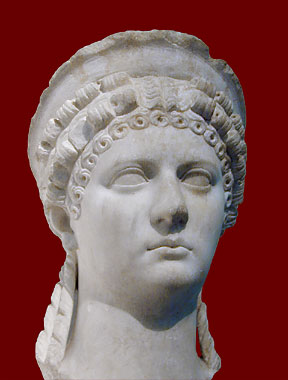 A daughter of the Julio-Claudian family, mid-1st century CE |
Vistilia is a conundrum. Daughter of a noble family, her brother is generally thought to be the Praetor Sextus Vistilius, who was a close friend of Drusus, the younger brother of the Emperor Tiberius. Tacitus reports that, high-born and socially prominent matrona though she was, she entered her name on the public list of prostitutes, blatantly flaunting the strict matronal code advocated by Augustus for the upper classes (see Social Class). While prostitution as a means of survival for a lower-class Roman woman, single or with family, was understandable, it is hard to explain why an aristocratic woman would resort to advertising her countercultural sexual behavior in that climate, especially in the knowledge that the two Julias, daughter and granddaughter of Augustus, had earlier been exiled for much less visible public immorality under the Lex Iulia de Maritandis. Perhaps Vistilia was testing the temper of the times under Tiberius, or was emulating the freedoms claimed by the "new women" of love elegy. Married six times, she had at least two children by the time of her conviction and exile in 19 CE. Her daughter, Milonia Caesonia, later also identified as a public prostitute, became the fourth wife of the Emperor Caligula. Vistilia's son, Gnaeus Domitius Corbulo, became a successful general and father to Domitia Longina, who married the Emperor Domitian. |
| (1) Eodem anno gravibus senatus decretis libido feminarum coercita cautumque ne quaestum corpore faceret cui avus aut pater aut maritus eques Romanus fuisset. | |
| (2) Nam Vistilia, praetoria familia genita, licentiam stupri apud aediles vulgaverat, more inter veteres recepto, qui satis poenarum adversum impudicas in ipsa professione flagitii credebant. | |
| (3) Exactum et a Titidio Labeone, Vistiliae marito, cur in uxore delicti manifesta ultionem legis omisisset. | |
| (4) Atque illo praetendente sexaginta dies ad consultandum datos necdum praeterisse, satis visum de Vistilia statuere; eaque in insulam Seriphon abdita est. |
Click on the underlined words for translation aids and
commentary, which will appear in a small window. Click on the
![]() icon link to the
right of the poem for related images and information. Close the small window
after each use.
icon link to the
right of the poem for related images and information. Close the small window
after each use.